Unit 6 – Micronutrients II: Minerals
VerifiedAdded on 2022/11/25
|11
|2365
|185
AI Summary
Explore the importance of minerals in the body, their functions, and their effects when deficient or in excess. Learn about calcium balance, vitamin D's role in calcium absorption, and the bioavailability of iron. Discover the impact of minerals on pregnancy and lactation, as well as inhibitory factors in calcium absorption. Understand conditions like osteoporosis and iron deficiency anemia. Find out about sodium and potassium's role in maintaining fluid balance and blood pressure. Gain insights into the relationship between salt and blood pressure, and the Na:K ATPase mechanism. Learn about iron status, haem and non-haem iron, and the effects of iron deficiency. Explore the vulnerability of certain population groups to iron deficiency.
Contribute Materials
Your contribution can guide someone’s learning journey. Share your
documents today.

Unit 6 – Micronutrients II:
Minerals
Minerals
Secure Best Marks with AI Grader
Need help grading? Try our AI Grader for instant feedback on your assignments.
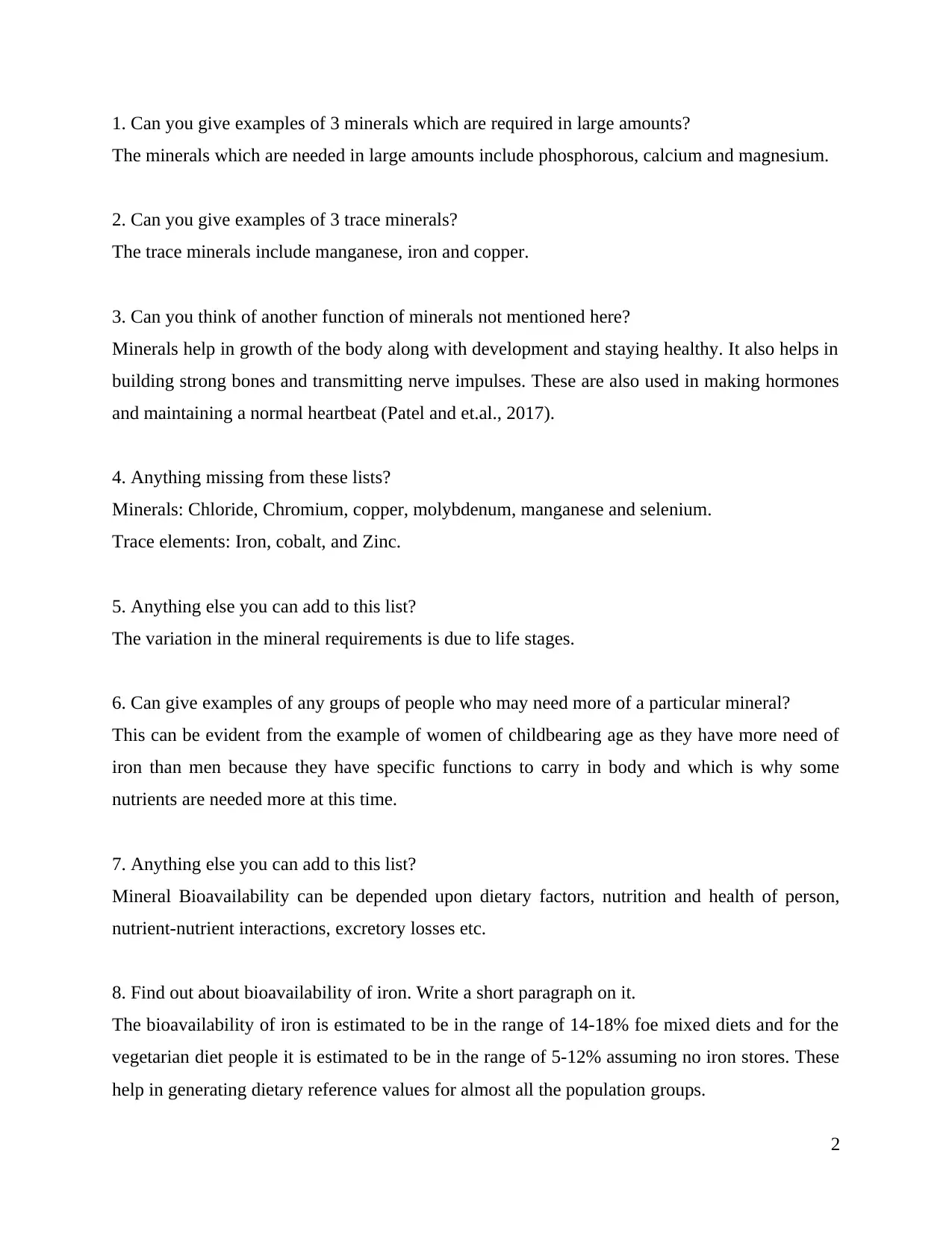
1. Can you give examples of 3 minerals which are required in large amounts?
The minerals which are needed in large amounts include phosphorous, calcium and magnesium.
2. Can you give examples of 3 trace minerals?
The trace minerals include manganese, iron and copper.
3. Can you think of another function of minerals not mentioned here?
Minerals help in growth of the body along with development and staying healthy. It also helps in
building strong bones and transmitting nerve impulses. These are also used in making hormones
and maintaining a normal heartbeat (Patel and et.al., 2017).
4. Anything missing from these lists?
Minerals: Chloride, Chromium, copper, molybdenum, manganese and selenium.
Trace elements: Iron, cobalt, and Zinc.
5. Anything else you can add to this list?
The variation in the mineral requirements is due to life stages.
6. Can give examples of any groups of people who may need more of a particular mineral?
This can be evident from the example of women of childbearing age as they have more need of
iron than men because they have specific functions to carry in body and which is why some
nutrients are needed more at this time.
7. Anything else you can add to this list?
Mineral Bioavailability can be depended upon dietary factors, nutrition and health of person,
nutrient-nutrient interactions, excretory losses etc.
8. Find out about bioavailability of iron. Write a short paragraph on it.
The bioavailability of iron is estimated to be in the range of 14-18% foe mixed diets and for the
vegetarian diet people it is estimated to be in the range of 5-12% assuming no iron stores. These
help in generating dietary reference values for almost all the population groups.
2
The minerals which are needed in large amounts include phosphorous, calcium and magnesium.
2. Can you give examples of 3 trace minerals?
The trace minerals include manganese, iron and copper.
3. Can you think of another function of minerals not mentioned here?
Minerals help in growth of the body along with development and staying healthy. It also helps in
building strong bones and transmitting nerve impulses. These are also used in making hormones
and maintaining a normal heartbeat (Patel and et.al., 2017).
4. Anything missing from these lists?
Minerals: Chloride, Chromium, copper, molybdenum, manganese and selenium.
Trace elements: Iron, cobalt, and Zinc.
5. Anything else you can add to this list?
The variation in the mineral requirements is due to life stages.
6. Can give examples of any groups of people who may need more of a particular mineral?
This can be evident from the example of women of childbearing age as they have more need of
iron than men because they have specific functions to carry in body and which is why some
nutrients are needed more at this time.
7. Anything else you can add to this list?
Mineral Bioavailability can be depended upon dietary factors, nutrition and health of person,
nutrient-nutrient interactions, excretory losses etc.
8. Find out about bioavailability of iron. Write a short paragraph on it.
The bioavailability of iron is estimated to be in the range of 14-18% foe mixed diets and for the
vegetarian diet people it is estimated to be in the range of 5-12% assuming no iron stores. These
help in generating dietary reference values for almost all the population groups.
2
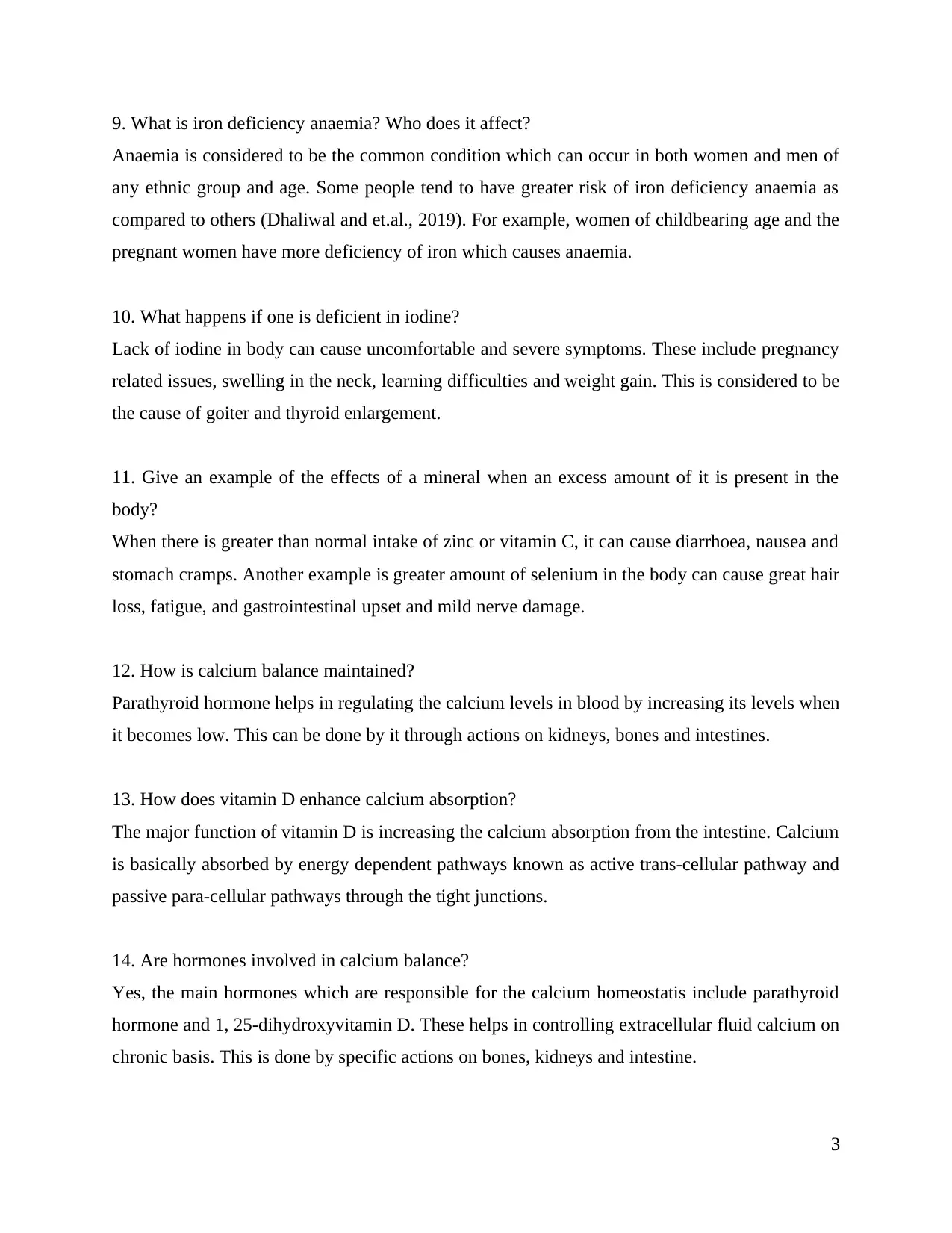
9. What is iron deficiency anaemia? Who does it affect?
Anaemia is considered to be the common condition which can occur in both women and men of
any ethnic group and age. Some people tend to have greater risk of iron deficiency anaemia as
compared to others (Dhaliwal and et.al., 2019). For example, women of childbearing age and the
pregnant women have more deficiency of iron which causes anaemia.
10. What happens if one is deficient in iodine?
Lack of iodine in body can cause uncomfortable and severe symptoms. These include pregnancy
related issues, swelling in the neck, learning difficulties and weight gain. This is considered to be
the cause of goiter and thyroid enlargement.
11. Give an example of the effects of a mineral when an excess amount of it is present in the
body?
When there is greater than normal intake of zinc or vitamin C, it can cause diarrhoea, nausea and
stomach cramps. Another example is greater amount of selenium in the body can cause great hair
loss, fatigue, and gastrointestinal upset and mild nerve damage.
12. How is calcium balance maintained?
Parathyroid hormone helps in regulating the calcium levels in blood by increasing its levels when
it becomes low. This can be done by it through actions on kidneys, bones and intestines.
13. How does vitamin D enhance calcium absorption?
The major function of vitamin D is increasing the calcium absorption from the intestine. Calcium
is basically absorbed by energy dependent pathways known as active trans-cellular pathway and
passive para-cellular pathways through the tight junctions.
14. Are hormones involved in calcium balance?
Yes, the main hormones which are responsible for the calcium homeostatis include parathyroid
hormone and 1, 25-dihydroxyvitamin D. These helps in controlling extracellular fluid calcium on
chronic basis. This is done by specific actions on bones, kidneys and intestine.
3
Anaemia is considered to be the common condition which can occur in both women and men of
any ethnic group and age. Some people tend to have greater risk of iron deficiency anaemia as
compared to others (Dhaliwal and et.al., 2019). For example, women of childbearing age and the
pregnant women have more deficiency of iron which causes anaemia.
10. What happens if one is deficient in iodine?
Lack of iodine in body can cause uncomfortable and severe symptoms. These include pregnancy
related issues, swelling in the neck, learning difficulties and weight gain. This is considered to be
the cause of goiter and thyroid enlargement.
11. Give an example of the effects of a mineral when an excess amount of it is present in the
body?
When there is greater than normal intake of zinc or vitamin C, it can cause diarrhoea, nausea and
stomach cramps. Another example is greater amount of selenium in the body can cause great hair
loss, fatigue, and gastrointestinal upset and mild nerve damage.
12. How is calcium balance maintained?
Parathyroid hormone helps in regulating the calcium levels in blood by increasing its levels when
it becomes low. This can be done by it through actions on kidneys, bones and intestines.
13. How does vitamin D enhance calcium absorption?
The major function of vitamin D is increasing the calcium absorption from the intestine. Calcium
is basically absorbed by energy dependent pathways known as active trans-cellular pathway and
passive para-cellular pathways through the tight junctions.
14. Are hormones involved in calcium balance?
Yes, the main hormones which are responsible for the calcium homeostatis include parathyroid
hormone and 1, 25-dihydroxyvitamin D. These helps in controlling extracellular fluid calcium on
chronic basis. This is done by specific actions on bones, kidneys and intestine.
3
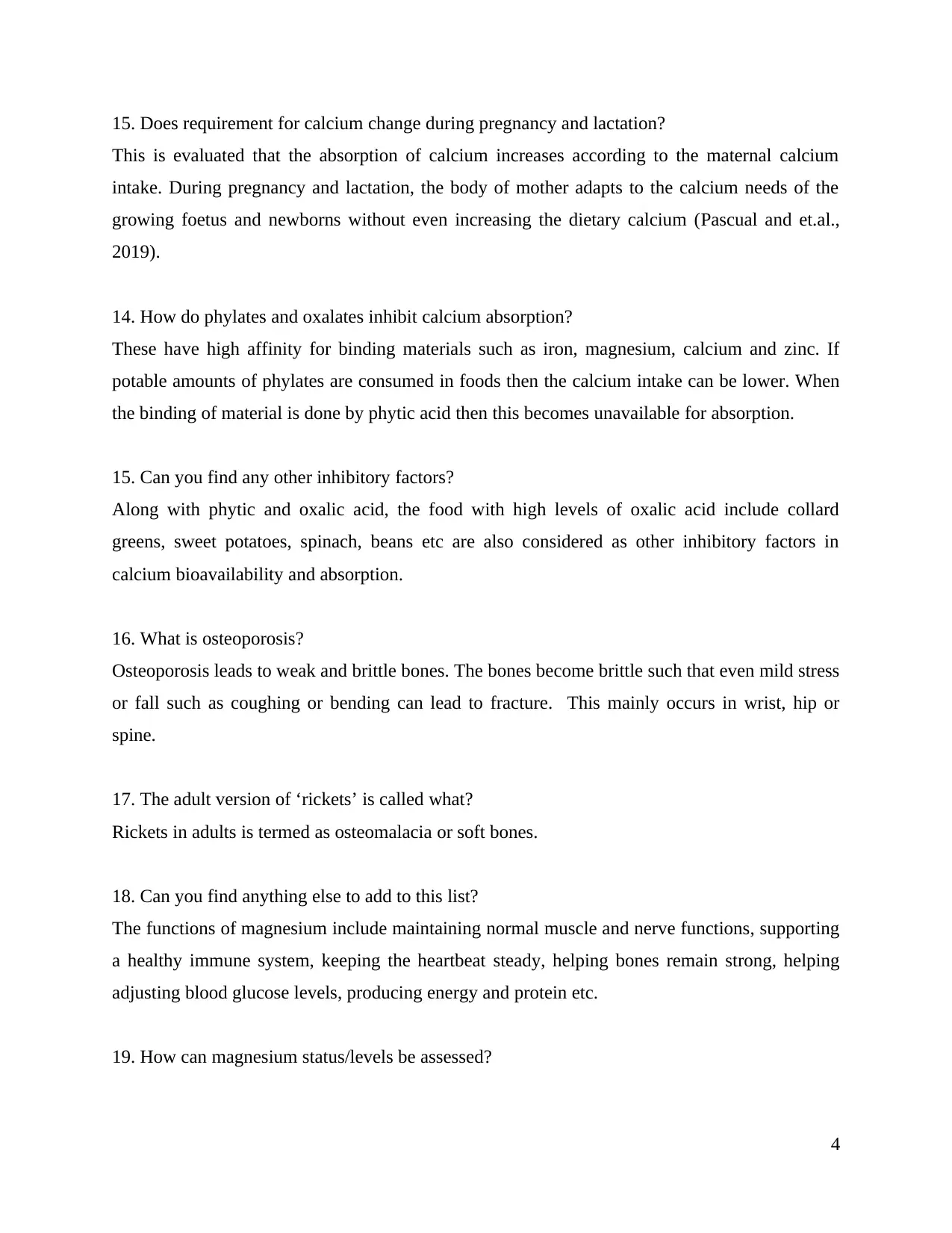
15. Does requirement for calcium change during pregnancy and lactation?
This is evaluated that the absorption of calcium increases according to the maternal calcium
intake. During pregnancy and lactation, the body of mother adapts to the calcium needs of the
growing foetus and newborns without even increasing the dietary calcium (Pascual and et.al.,
2019).
14. How do phylates and oxalates inhibit calcium absorption?
These have high affinity for binding materials such as iron, magnesium, calcium and zinc. If
potable amounts of phylates are consumed in foods then the calcium intake can be lower. When
the binding of material is done by phytic acid then this becomes unavailable for absorption.
15. Can you find any other inhibitory factors?
Along with phytic and oxalic acid, the food with high levels of oxalic acid include collard
greens, sweet potatoes, spinach, beans etc are also considered as other inhibitory factors in
calcium bioavailability and absorption.
16. What is osteoporosis?
Osteoporosis leads to weak and brittle bones. The bones become brittle such that even mild stress
or fall such as coughing or bending can lead to fracture. This mainly occurs in wrist, hip or
spine.
17. The adult version of ‘rickets’ is called what?
Rickets in adults is termed as osteomalacia or soft bones.
18. Can you find anything else to add to this list?
The functions of magnesium include maintaining normal muscle and nerve functions, supporting
a healthy immune system, keeping the heartbeat steady, helping bones remain strong, helping
adjusting blood glucose levels, producing energy and protein etc.
19. How can magnesium status/levels be assessed?
4
This is evaluated that the absorption of calcium increases according to the maternal calcium
intake. During pregnancy and lactation, the body of mother adapts to the calcium needs of the
growing foetus and newborns without even increasing the dietary calcium (Pascual and et.al.,
2019).
14. How do phylates and oxalates inhibit calcium absorption?
These have high affinity for binding materials such as iron, magnesium, calcium and zinc. If
potable amounts of phylates are consumed in foods then the calcium intake can be lower. When
the binding of material is done by phytic acid then this becomes unavailable for absorption.
15. Can you find any other inhibitory factors?
Along with phytic and oxalic acid, the food with high levels of oxalic acid include collard
greens, sweet potatoes, spinach, beans etc are also considered as other inhibitory factors in
calcium bioavailability and absorption.
16. What is osteoporosis?
Osteoporosis leads to weak and brittle bones. The bones become brittle such that even mild stress
or fall such as coughing or bending can lead to fracture. This mainly occurs in wrist, hip or
spine.
17. The adult version of ‘rickets’ is called what?
Rickets in adults is termed as osteomalacia or soft bones.
18. Can you find anything else to add to this list?
The functions of magnesium include maintaining normal muscle and nerve functions, supporting
a healthy immune system, keeping the heartbeat steady, helping bones remain strong, helping
adjusting blood glucose levels, producing energy and protein etc.
19. How can magnesium status/levels be assessed?
4
Secure Best Marks with AI Grader
Need help grading? Try our AI Grader for instant feedback on your assignments.
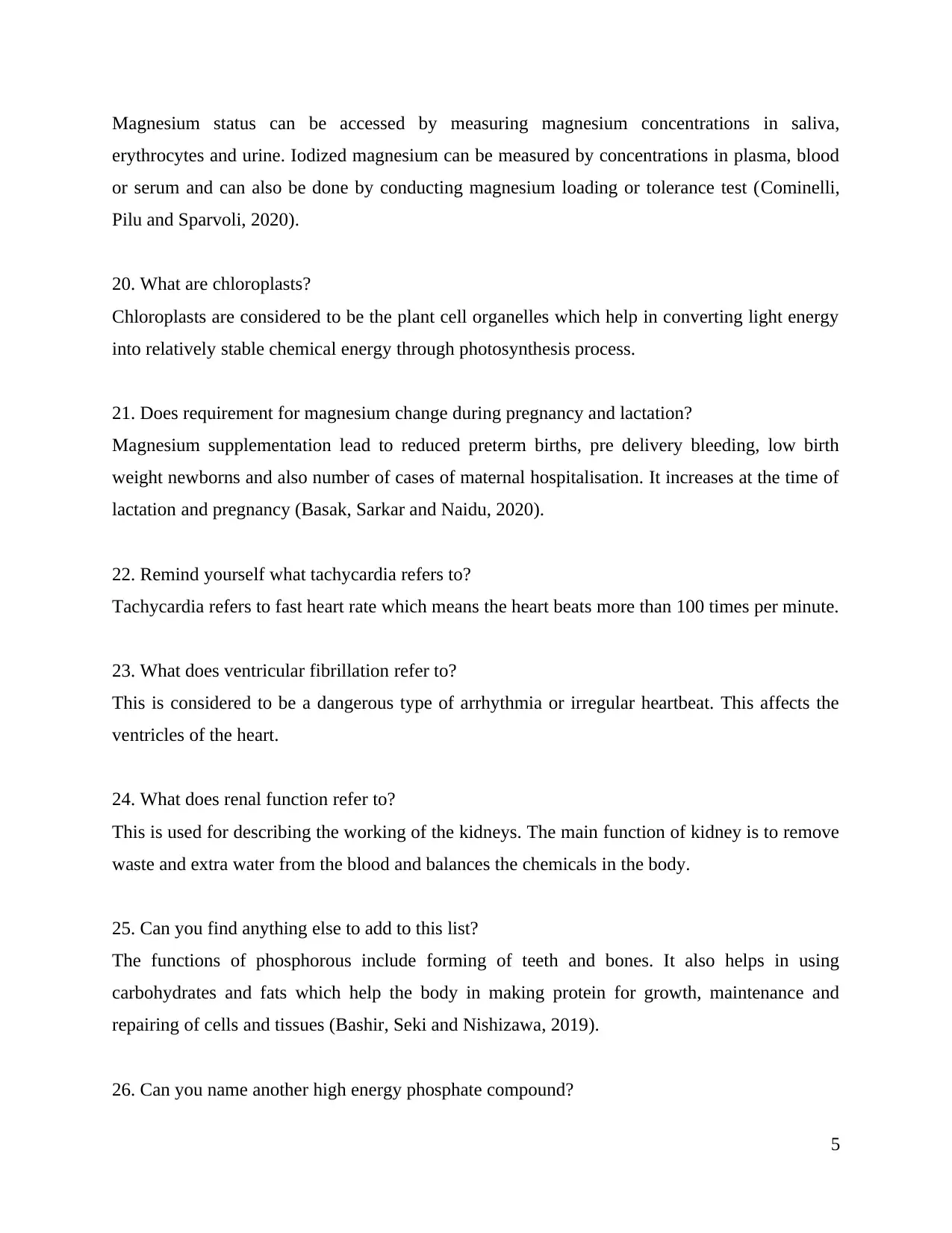
Magnesium status can be accessed by measuring magnesium concentrations in saliva,
erythrocytes and urine. Iodized magnesium can be measured by concentrations in plasma, blood
or serum and can also be done by conducting magnesium loading or tolerance test (Cominelli,
Pilu and Sparvoli, 2020).
20. What are chloroplasts?
Chloroplasts are considered to be the plant cell organelles which help in converting light energy
into relatively stable chemical energy through photosynthesis process.
21. Does requirement for magnesium change during pregnancy and lactation?
Magnesium supplementation lead to reduced preterm births, pre delivery bleeding, low birth
weight newborns and also number of cases of maternal hospitalisation. It increases at the time of
lactation and pregnancy (Basak, Sarkar and Naidu, 2020).
22. Remind yourself what tachycardia refers to?
Tachycardia refers to fast heart rate which means the heart beats more than 100 times per minute.
23. What does ventricular fibrillation refer to?
This is considered to be a dangerous type of arrhythmia or irregular heartbeat. This affects the
ventricles of the heart.
24. What does renal function refer to?
This is used for describing the working of the kidneys. The main function of kidney is to remove
waste and extra water from the blood and balances the chemicals in the body.
25. Can you find anything else to add to this list?
The functions of phosphorous include forming of teeth and bones. It also helps in using
carbohydrates and fats which help the body in making protein for growth, maintenance and
repairing of cells and tissues (Bashir, Seki and Nishizawa, 2019).
26. Can you name another high energy phosphate compound?
5
erythrocytes and urine. Iodized magnesium can be measured by concentrations in plasma, blood
or serum and can also be done by conducting magnesium loading or tolerance test (Cominelli,
Pilu and Sparvoli, 2020).
20. What are chloroplasts?
Chloroplasts are considered to be the plant cell organelles which help in converting light energy
into relatively stable chemical energy through photosynthesis process.
21. Does requirement for magnesium change during pregnancy and lactation?
Magnesium supplementation lead to reduced preterm births, pre delivery bleeding, low birth
weight newborns and also number of cases of maternal hospitalisation. It increases at the time of
lactation and pregnancy (Basak, Sarkar and Naidu, 2020).
22. Remind yourself what tachycardia refers to?
Tachycardia refers to fast heart rate which means the heart beats more than 100 times per minute.
23. What does ventricular fibrillation refer to?
This is considered to be a dangerous type of arrhythmia or irregular heartbeat. This affects the
ventricles of the heart.
24. What does renal function refer to?
This is used for describing the working of the kidneys. The main function of kidney is to remove
waste and extra water from the blood and balances the chemicals in the body.
25. Can you find anything else to add to this list?
The functions of phosphorous include forming of teeth and bones. It also helps in using
carbohydrates and fats which help the body in making protein for growth, maintenance and
repairing of cells and tissues (Bashir, Seki and Nishizawa, 2019).
26. Can you name another high energy phosphate compound?
5
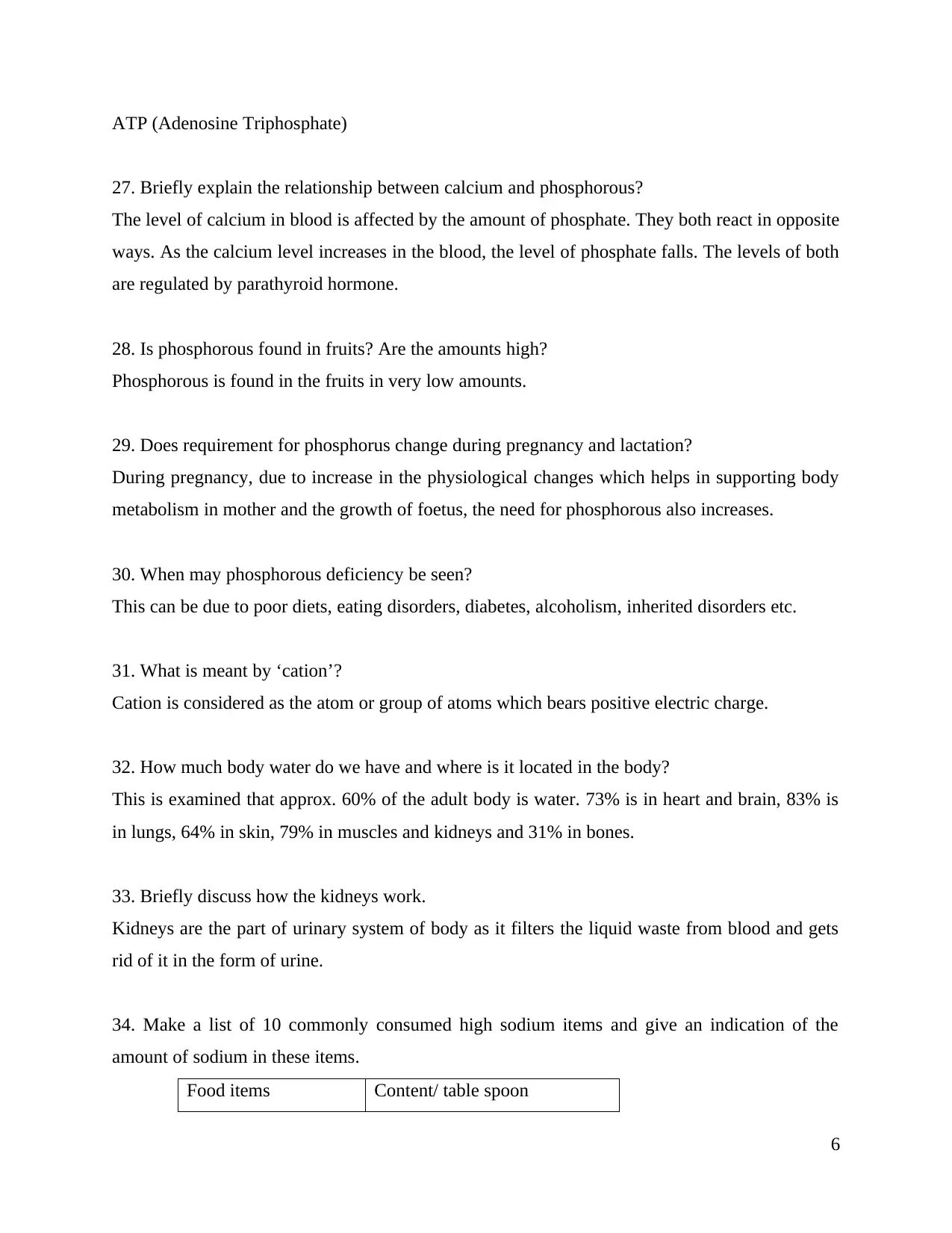
ATP (Adenosine Triphosphate)
27. Briefly explain the relationship between calcium and phosphorous?
The level of calcium in blood is affected by the amount of phosphate. They both react in opposite
ways. As the calcium level increases in the blood, the level of phosphate falls. The levels of both
are regulated by parathyroid hormone.
28. Is phosphorous found in fruits? Are the amounts high?
Phosphorous is found in the fruits in very low amounts.
29. Does requirement for phosphorus change during pregnancy and lactation?
During pregnancy, due to increase in the physiological changes which helps in supporting body
metabolism in mother and the growth of foetus, the need for phosphorous also increases.
30. When may phosphorous deficiency be seen?
This can be due to poor diets, eating disorders, diabetes, alcoholism, inherited disorders etc.
31. What is meant by ‘cation’?
Cation is considered as the atom or group of atoms which bears positive electric charge.
32. How much body water do we have and where is it located in the body?
This is examined that approx. 60% of the adult body is water. 73% is in heart and brain, 83% is
in lungs, 64% in skin, 79% in muscles and kidneys and 31% in bones.
33. Briefly discuss how the kidneys work.
Kidneys are the part of urinary system of body as it filters the liquid waste from blood and gets
rid of it in the form of urine.
34. Make a list of 10 commonly consumed high sodium items and give an indication of the
amount of sodium in these items.
Food items Content/ table spoon
6
27. Briefly explain the relationship between calcium and phosphorous?
The level of calcium in blood is affected by the amount of phosphate. They both react in opposite
ways. As the calcium level increases in the blood, the level of phosphate falls. The levels of both
are regulated by parathyroid hormone.
28. Is phosphorous found in fruits? Are the amounts high?
Phosphorous is found in the fruits in very low amounts.
29. Does requirement for phosphorus change during pregnancy and lactation?
During pregnancy, due to increase in the physiological changes which helps in supporting body
metabolism in mother and the growth of foetus, the need for phosphorous also increases.
30. When may phosphorous deficiency be seen?
This can be due to poor diets, eating disorders, diabetes, alcoholism, inherited disorders etc.
31. What is meant by ‘cation’?
Cation is considered as the atom or group of atoms which bears positive electric charge.
32. How much body water do we have and where is it located in the body?
This is examined that approx. 60% of the adult body is water. 73% is in heart and brain, 83% is
in lungs, 64% in skin, 79% in muscles and kidneys and 31% in bones.
33. Briefly discuss how the kidneys work.
Kidneys are the part of urinary system of body as it filters the liquid waste from blood and gets
rid of it in the form of urine.
34. Make a list of 10 commonly consumed high sodium items and give an indication of the
amount of sodium in these items.
Food items Content/ table spoon
6
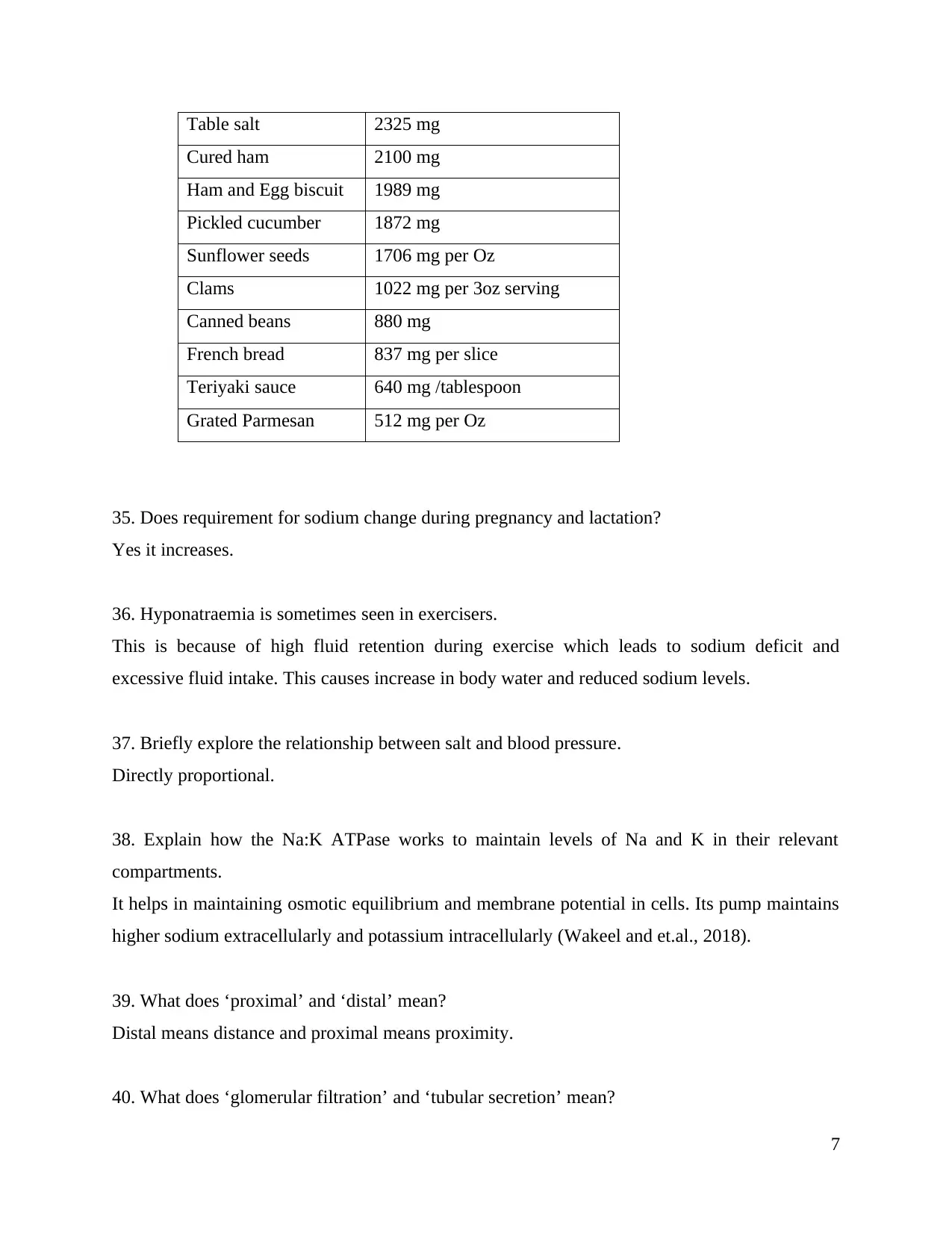
Table salt 2325 mg
Cured ham 2100 mg
Ham and Egg biscuit 1989 mg
Pickled cucumber 1872 mg
Sunflower seeds 1706 mg per Oz
Clams 1022 mg per 3oz serving
Canned beans 880 mg
French bread 837 mg per slice
Teriyaki sauce 640 mg /tablespoon
Grated Parmesan 512 mg per Oz
35. Does requirement for sodium change during pregnancy and lactation?
Yes it increases.
36. Hyponatraemia is sometimes seen in exercisers.
This is because of high fluid retention during exercise which leads to sodium deficit and
excessive fluid intake. This causes increase in body water and reduced sodium levels.
37. Briefly explore the relationship between salt and blood pressure.
Directly proportional.
38. Explain how the Na:K ATPase works to maintain levels of Na and K in their relevant
compartments.
It helps in maintaining osmotic equilibrium and membrane potential in cells. Its pump maintains
higher sodium extracellularly and potassium intracellularly (Wakeel and et.al., 2018).
39. What does ‘proximal’ and ‘distal’ mean?
Distal means distance and proximal means proximity.
40. What does ‘glomerular filtration’ and ‘tubular secretion’ mean?
7
Cured ham 2100 mg
Ham and Egg biscuit 1989 mg
Pickled cucumber 1872 mg
Sunflower seeds 1706 mg per Oz
Clams 1022 mg per 3oz serving
Canned beans 880 mg
French bread 837 mg per slice
Teriyaki sauce 640 mg /tablespoon
Grated Parmesan 512 mg per Oz
35. Does requirement for sodium change during pregnancy and lactation?
Yes it increases.
36. Hyponatraemia is sometimes seen in exercisers.
This is because of high fluid retention during exercise which leads to sodium deficit and
excessive fluid intake. This causes increase in body water and reduced sodium levels.
37. Briefly explore the relationship between salt and blood pressure.
Directly proportional.
38. Explain how the Na:K ATPase works to maintain levels of Na and K in their relevant
compartments.
It helps in maintaining osmotic equilibrium and membrane potential in cells. Its pump maintains
higher sodium extracellularly and potassium intracellularly (Wakeel and et.al., 2018).
39. What does ‘proximal’ and ‘distal’ mean?
Distal means distance and proximal means proximity.
40. What does ‘glomerular filtration’ and ‘tubular secretion’ mean?
7
Paraphrase This Document
Need a fresh take? Get an instant paraphrase of this document with our AI Paraphraser
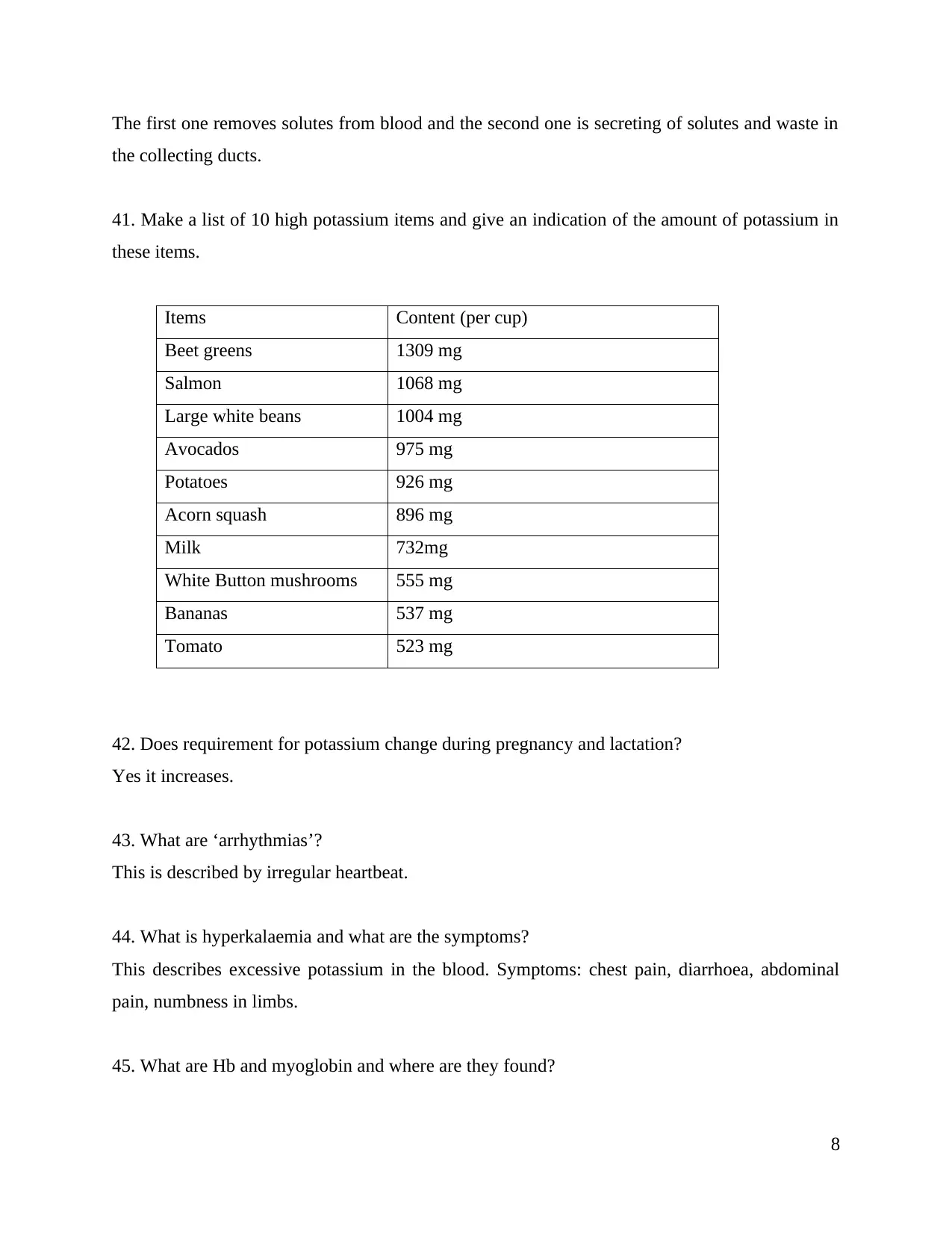
The first one removes solutes from blood and the second one is secreting of solutes and waste in
the collecting ducts.
41. Make a list of 10 high potassium items and give an indication of the amount of potassium in
these items.
Items Content (per cup)
Beet greens 1309 mg
Salmon 1068 mg
Large white beans 1004 mg
Avocados 975 mg
Potatoes 926 mg
Acorn squash 896 mg
Milk 732mg
White Button mushrooms 555 mg
Bananas 537 mg
Tomato 523 mg
42. Does requirement for potassium change during pregnancy and lactation?
Yes it increases.
43. What are ‘arrhythmias’?
This is described by irregular heartbeat.
44. What is hyperkalaemia and what are the symptoms?
This describes excessive potassium in the blood. Symptoms: chest pain, diarrhoea, abdominal
pain, numbness in limbs.
45. What are Hb and myoglobin and where are they found?
8
the collecting ducts.
41. Make a list of 10 high potassium items and give an indication of the amount of potassium in
these items.
Items Content (per cup)
Beet greens 1309 mg
Salmon 1068 mg
Large white beans 1004 mg
Avocados 975 mg
Potatoes 926 mg
Acorn squash 896 mg
Milk 732mg
White Button mushrooms 555 mg
Bananas 537 mg
Tomato 523 mg
42. Does requirement for potassium change during pregnancy and lactation?
Yes it increases.
43. What are ‘arrhythmias’?
This is described by irregular heartbeat.
44. What is hyperkalaemia and what are the symptoms?
This describes excessive potassium in the blood. Symptoms: chest pain, diarrhoea, abdominal
pain, numbness in limbs.
45. What are Hb and myoglobin and where are they found?
8
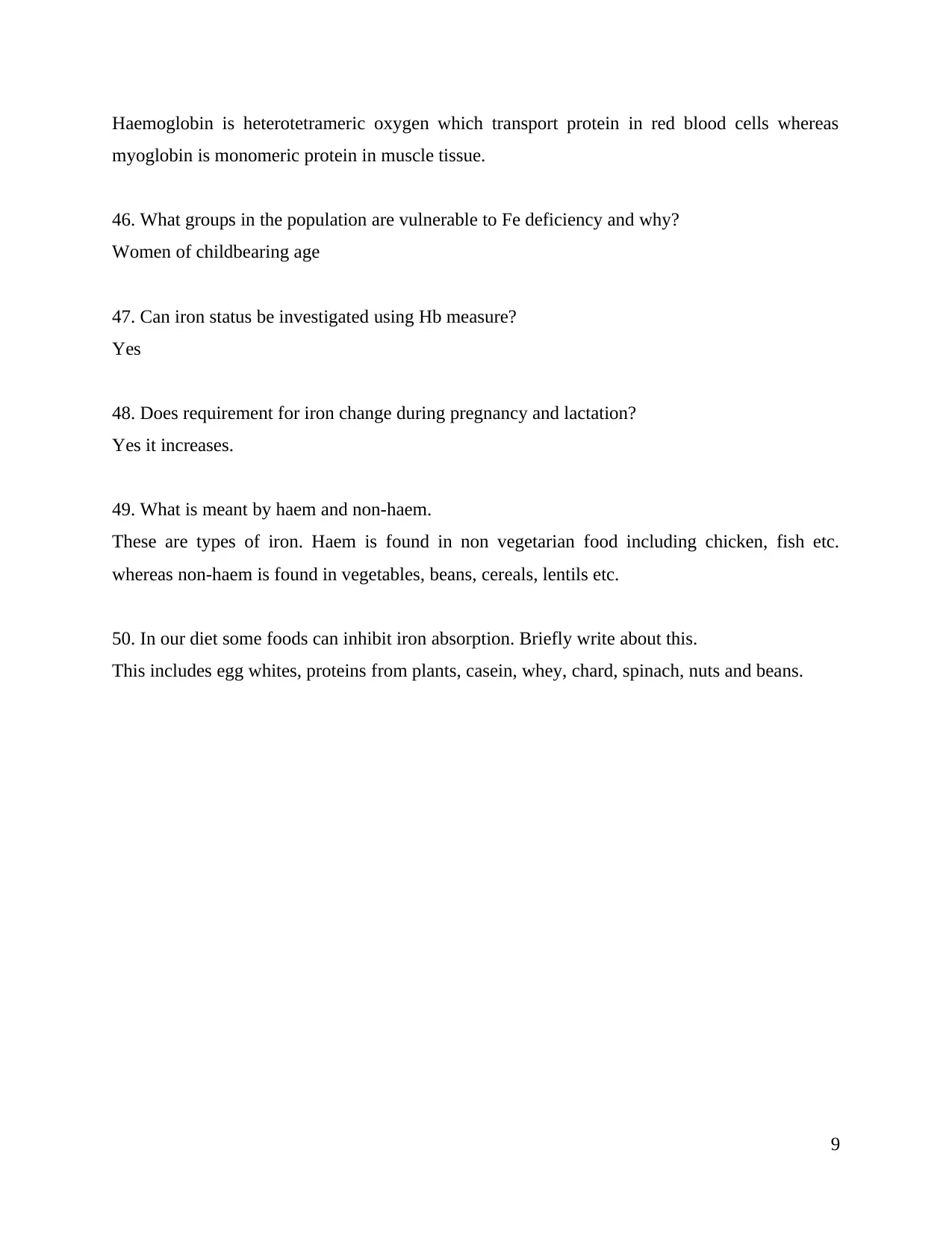
Haemoglobin is heterotetrameric oxygen which transport protein in red blood cells whereas
myoglobin is monomeric protein in muscle tissue.
46. What groups in the population are vulnerable to Fe deficiency and why?
Women of childbearing age
47. Can iron status be investigated using Hb measure?
Yes
48. Does requirement for iron change during pregnancy and lactation?
Yes it increases.
49. What is meant by haem and non-haem.
These are types of iron. Haem is found in non vegetarian food including chicken, fish etc.
whereas non-haem is found in vegetables, beans, cereals, lentils etc.
50. In our diet some foods can inhibit iron absorption. Briefly write about this.
This includes egg whites, proteins from plants, casein, whey, chard, spinach, nuts and beans.
9
myoglobin is monomeric protein in muscle tissue.
46. What groups in the population are vulnerable to Fe deficiency and why?
Women of childbearing age
47. Can iron status be investigated using Hb measure?
Yes
48. Does requirement for iron change during pregnancy and lactation?
Yes it increases.
49. What is meant by haem and non-haem.
These are types of iron. Haem is found in non vegetarian food including chicken, fish etc.
whereas non-haem is found in vegetables, beans, cereals, lentils etc.
50. In our diet some foods can inhibit iron absorption. Briefly write about this.
This includes egg whites, proteins from plants, casein, whey, chard, spinach, nuts and beans.
9
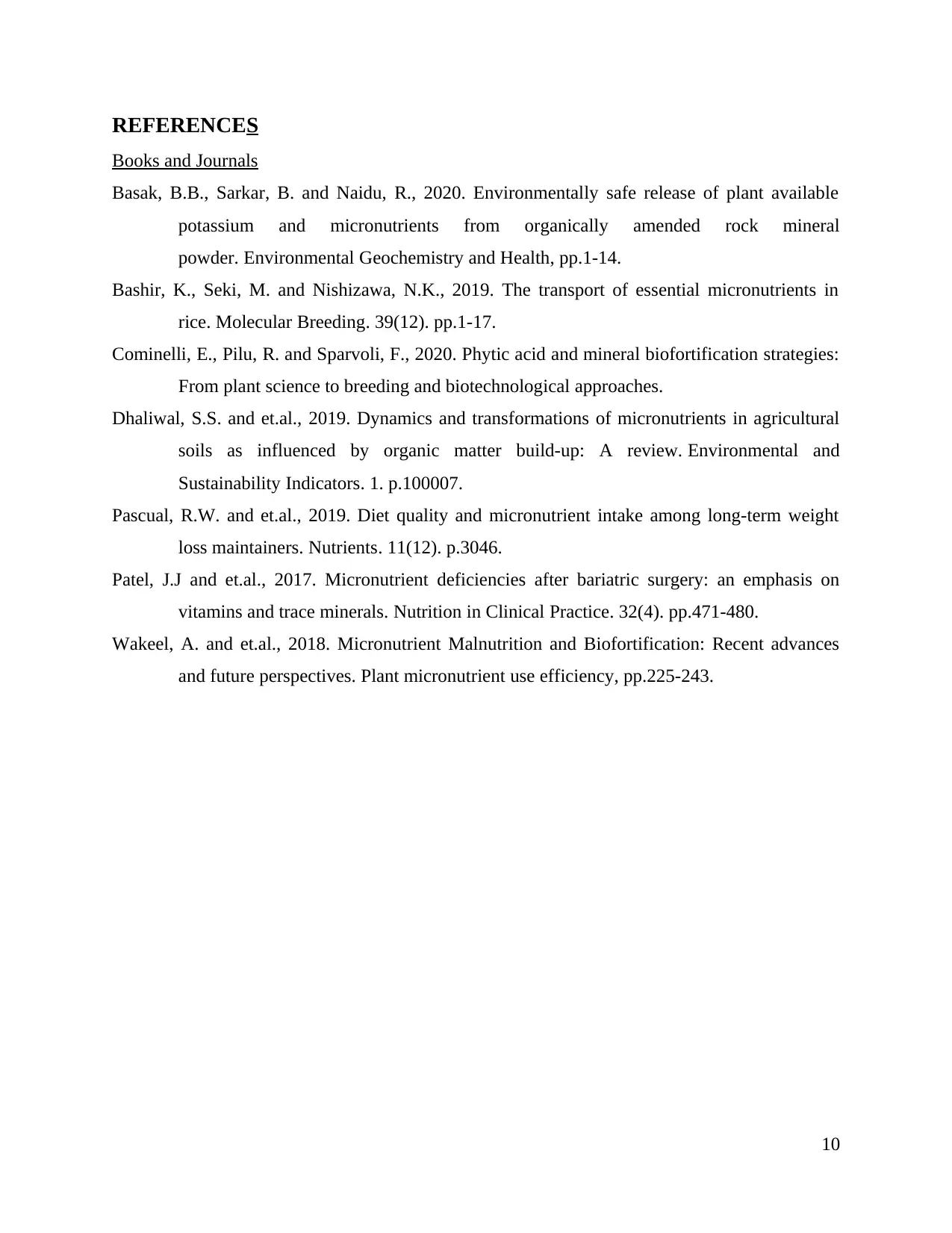
REFERENCES
Books and Journals
Basak, B.B., Sarkar, B. and Naidu, R., 2020. Environmentally safe release of plant available
potassium and micronutrients from organically amended rock mineral
powder. Environmental Geochemistry and Health, pp.1-14.
Bashir, K., Seki, M. and Nishizawa, N.K., 2019. The transport of essential micronutrients in
rice. Molecular Breeding. 39(12). pp.1-17.
Cominelli, E., Pilu, R. and Sparvoli, F., 2020. Phytic acid and mineral biofortification strategies:
From plant science to breeding and biotechnological approaches.
Dhaliwal, S.S. and et.al., 2019. Dynamics and transformations of micronutrients in agricultural
soils as influenced by organic matter build-up: A review. Environmental and
Sustainability Indicators. 1. p.100007.
Pascual, R.W. and et.al., 2019. Diet quality and micronutrient intake among long-term weight
loss maintainers. Nutrients. 11(12). p.3046.
Patel, J.J and et.al., 2017. Micronutrient deficiencies after bariatric surgery: an emphasis on
vitamins and trace minerals. Nutrition in Clinical Practice. 32(4). pp.471-480.
Wakeel, A. and et.al., 2018. Micronutrient Malnutrition and Biofortification: Recent advances
and future perspectives. Plant micronutrient use efficiency, pp.225-243.
10
Books and Journals
Basak, B.B., Sarkar, B. and Naidu, R., 2020. Environmentally safe release of plant available
potassium and micronutrients from organically amended rock mineral
powder. Environmental Geochemistry and Health, pp.1-14.
Bashir, K., Seki, M. and Nishizawa, N.K., 2019. The transport of essential micronutrients in
rice. Molecular Breeding. 39(12). pp.1-17.
Cominelli, E., Pilu, R. and Sparvoli, F., 2020. Phytic acid and mineral biofortification strategies:
From plant science to breeding and biotechnological approaches.
Dhaliwal, S.S. and et.al., 2019. Dynamics and transformations of micronutrients in agricultural
soils as influenced by organic matter build-up: A review. Environmental and
Sustainability Indicators. 1. p.100007.
Pascual, R.W. and et.al., 2019. Diet quality and micronutrient intake among long-term weight
loss maintainers. Nutrients. 11(12). p.3046.
Patel, J.J and et.al., 2017. Micronutrient deficiencies after bariatric surgery: an emphasis on
vitamins and trace minerals. Nutrition in Clinical Practice. 32(4). pp.471-480.
Wakeel, A. and et.al., 2018. Micronutrient Malnutrition and Biofortification: Recent advances
and future perspectives. Plant micronutrient use efficiency, pp.225-243.
10
Secure Best Marks with AI Grader
Need help grading? Try our AI Grader for instant feedback on your assignments.

11
1 out of 11
Your All-in-One AI-Powered Toolkit for Academic Success.
+13062052269
info@desklib.com
Available 24*7 on WhatsApp / Email
![[object Object]](/_next/static/media/star-bottom.7253800d.svg)
Unlock your academic potential
© 2024 | Zucol Services PVT LTD | All rights reserved.